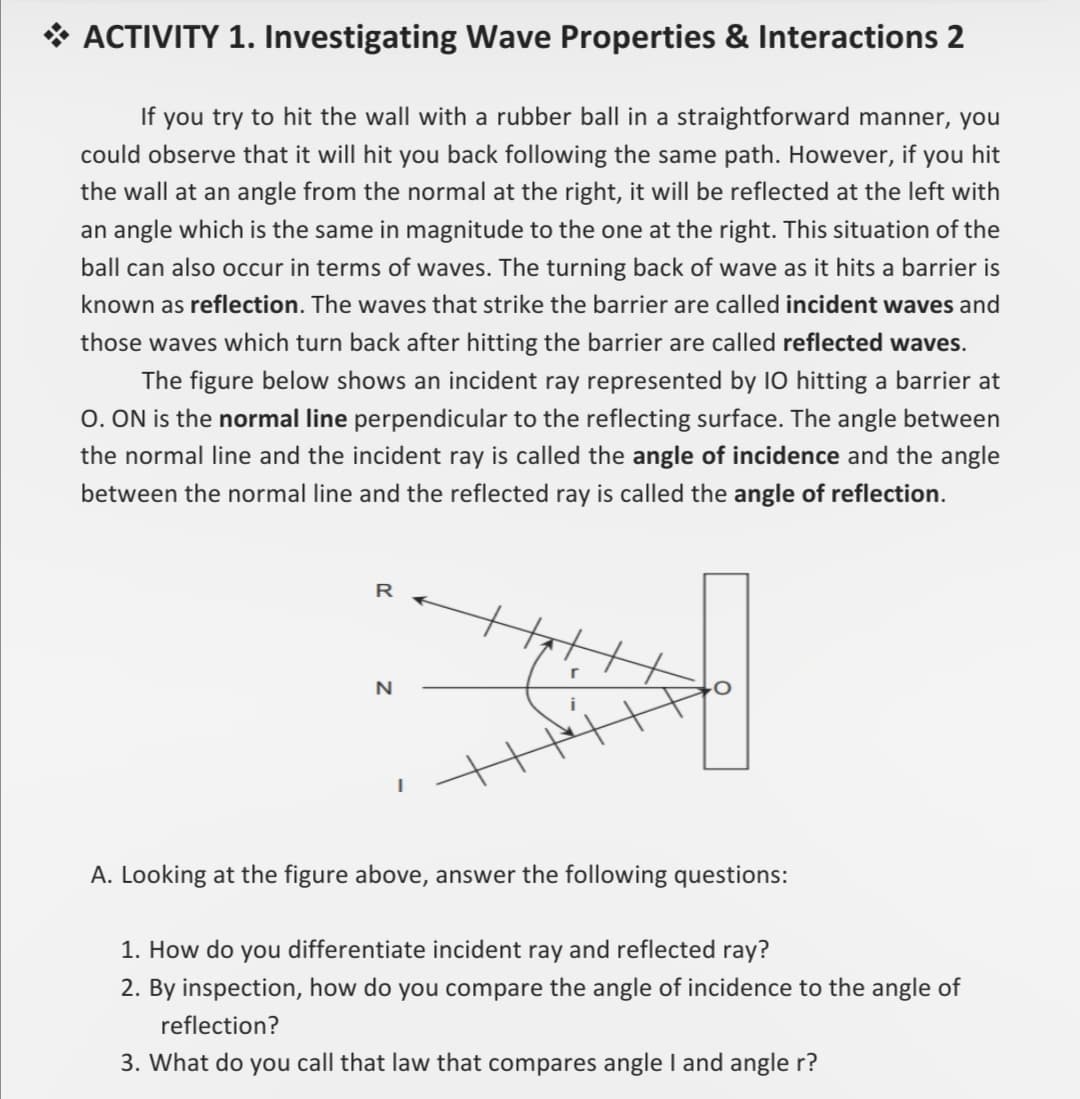* ACTIVITY 1. Investigating Wave Properties & Interactions 2 If you try to hit the wall with a rubber ball in a straightforward manner, you could observe that it will hit you back following the same path. However, if you hit the wall at an angle from the normal at the right, it will be reflected at the left with an angle which is the same in magnitude to the one at the right. This situation of the ball can also occur in terms of waves. The turning back of wave as it hits a barrier is known as reflection. The waves that strike the barrier are called incident waves and those waves which turn back after hitting the barrier are called reflected waves. The figure below shows an incident ray represented by 10 hitting a barrier at 0. ON is the normal line perpendicular to the reflecting surface. The angle between the normal line and the incident ray is called the angle of incidence and the angle between the normal line and the reflected ray is called the angle of reflection. R to A. Looking at the figure above, answer the following questions: 1. How do you differentiate incident ray and reflected ray? 2. By inspection, how do you compare the angle of incidence to the angle of reflection? 3. What do you call that law that compares angle I and angle r?
* ACTIVITY 1. Investigating Wave Properties & Interactions 2 If you try to hit the wall with a rubber ball in a straightforward manner, you could observe that it will hit you back following the same path. However, if you hit the wall at an angle from the normal at the right, it will be reflected at the left with an angle which is the same in magnitude to the one at the right. This situation of the ball can also occur in terms of waves. The turning back of wave as it hits a barrier is known as reflection. The waves that strike the barrier are called incident waves and those waves which turn back after hitting the barrier are called reflected waves. The figure below shows an incident ray represented by 10 hitting a barrier at 0. ON is the normal line perpendicular to the reflecting surface. The angle between the normal line and the incident ray is called the angle of incidence and the angle between the normal line and the reflected ray is called the angle of reflection. R to A. Looking at the figure above, answer the following questions: 1. How do you differentiate incident ray and reflected ray? 2. By inspection, how do you compare the angle of incidence to the angle of reflection? 3. What do you call that law that compares angle I and angle r?
Physics for Scientists and Engineers with Modern Physics
10th Edition
ISBN:9781337553292
Author:Raymond A. Serway, John W. Jewett
Publisher:Raymond A. Serway, John W. Jewett
Chapter40: Quantum Mechanics
Section: Chapter Questions
Problem 30P: Two particles with masses m1 and m2 are joined by a light spring of force constant k. They vibrate...
Related questions
Question
Can someone help me answer this questions ASAP. #2 only.

Transcribed Image Text:* ACTIVITY 1. Investigating Wave Properties & Interactions 2
If you try to hit the wall with a rubber ball in a straightforward manner, you
could observe that it will hit you back following the same path. However, if you hit
the wall at an angle from the normal at the right, it will be reflected at the left with
an angle which is the same in magnitude to the one at the right. This situation of the
ball can also occur in terms of waves. The turning back of wave as it hits a barrier is
known as reflection. The waves that strike the barrier are called incident waves and
those waves which turn back after hitting the barrier are called reflected waves.
The figure below shows an incident ray represented by I0 hitting a barrier at
0. ON is the normal line perpendicular to the reflecting surface. The angle between
the normal line and the incident ray is called the angle of incidence and the angle
between the normal line and the reflected ray is called the angle of reflection.
R
Looking at the figure above, answer the following questions:
1. How do you differentiate incident ray and reflected ray?
2. By inspection, how do you compare the angle of incidence to the angle of
reflection?
3. What do you call that law that compares angle I and angle r?
Expert Solution
This question has been solved!
Explore an expertly crafted, step-by-step solution for a thorough understanding of key concepts.
This is a popular solution!
Trending now
This is a popular solution!
Step by step
Solved in 2 steps

Recommended textbooks for you

Physics for Scientists and Engineers with Modern …
Physics
ISBN:
9781337553292
Author:
Raymond A. Serway, John W. Jewett
Publisher:
Cengage Learning

Modern Physics
Physics
ISBN:
9781111794378
Author:
Raymond A. Serway, Clement J. Moses, Curt A. Moyer
Publisher:
Cengage Learning

University Physics Volume 3
Physics
ISBN:
9781938168185
Author:
William Moebs, Jeff Sanny
Publisher:
OpenStax

Physics for Scientists and Engineers with Modern …
Physics
ISBN:
9781337553292
Author:
Raymond A. Serway, John W. Jewett
Publisher:
Cengage Learning

Modern Physics
Physics
ISBN:
9781111794378
Author:
Raymond A. Serway, Clement J. Moses, Curt A. Moyer
Publisher:
Cengage Learning

University Physics Volume 3
Physics
ISBN:
9781938168185
Author:
William Moebs, Jeff Sanny
Publisher:
OpenStax

Physics for Scientists and Engineers, Technology …
Physics
ISBN:
9781305116399
Author:
Raymond A. Serway, John W. Jewett
Publisher:
Cengage Learning

Physics for Scientists and Engineers: Foundations…
Physics
ISBN:
9781133939146
Author:
Katz, Debora M.
Publisher:
Cengage Learning